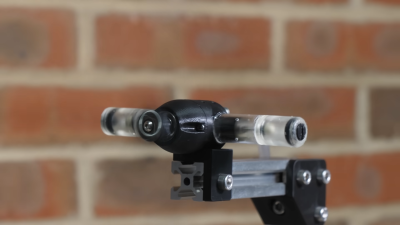Compressed air isn’t really a practical form of energy storage for headline uses like transport or heating, but it’s a fun thing to tinker with at the small scale. [Tom Stanton] is plenty experienced in that area, having built a series of compressed air engines over the years. His latest effort is capable of running at up to 4,500 RPM, and delivering a full 0.05 horsepower.

[Tom’s] ultimate goal is to put his new tiny air engine on a small model aircraft. To enable consistent performance, his engine needs a regulator, but off-the-shelf models for industrial use were too hefty for his use. Thus, he set about equipping his engine with a lightweight regulator of his own 3D-printed design.
His latest ball-valve air engine was then designed to run on this lower regulated pressure of approximately 30 psi. It initially proved less efficient than his previous designs, but some engineering analysis revealed the problem. [Tom] does a great job of stepping through his process of understanding how these engines perform, and how he uses these findings to guide his design choices going forward.
It’s also great to see a YouTuber not just building fun things, but taking measurements and doing some real engineering. [Tom’s] air engines keep getting better, and we can’t wait to see where he takes his designs next.
















There was a dude named Gasparin that made small CO2 motors sufficient for powering peanut scale free flight airplanes. They haven’t been made for about 20 years but the general principle was a piston with a peg on top of it. At the top of the cylinder was a simple ball bearing that the peg pushed up at TDC to admit some amount of the CO2. From what I’ve read they were tiny, light, dead simple and very effective.
In addition to the simple and practical ones he also had like V12’s and stuff that were artwork more than anything else.
Wow looks like he is still making motors. Last I looked a while ago I figured he stopped. A random sample:
http://www.gasparin.cz/page.php?page=co2/products/gmotors/product_info&lng=en&type=G28T
Spins at 2500 RPM, weighs 12g, spins for 6 minutes or more depending on CO2 charge.
These engines have worked like that from the beginning, but the real challenge is acheiving efficiency.
That’s what Toms first design was
Can anyone make this find the file for this engine
At:
https://www.youtube.com/watch?v=fE_LjQ4IBQQ
Integza built an air engine that uses an electrically controlled inlet valve. He hopes to use this on a plane, but IMHO, it’s too heavy and complex. Good video though.
Integza also weirdly chose to time his valve with a sensor in the head which really limits his ability to adjust the timing. If he does another iteration it really should relocate the magnet and sensor to the flywheel.
I wonder how long this would run on those little aluminium compressed air cartridges for pumping up bicycle tires or perhaps an air duster aerosol can.
A free flight aircraft that you pump up with a tire pump, I love it! Two liter bottle max pressure 100Psi, do not exceed 130Psi from here; http://www.water-rockets.com/article.pl?106,0
Air Hogs is a Canadian kid’s toy line that’s been using air motors since some time in the last millennium. It would be interesting to see how Stanton’s click-fodder efforts compare.
I think he started with some Air hogs to get his initial design. He is iterating and using slow motion video to catch the valve action.
I think he bench tested against an Air Hog, probably at least in the ballpark.
His engine is far more efficient now.
He tested against one recently.
Who is today’s sponsor?
He’s made a tonne of videos about variations. The last one was alright and the newest is reasonably impressive/efficient. I don’t think there’s anything wrong with posts about cool creative stuff.
Pardon my ignorance, but wouldn’t a turbine be better suited for transforming pressurized air into rotational motion?
Doesn’t that depend on constant high pressure?
such a small turbine would have to spin very fast, i.e. lots of friction and then you’d need a gearbox adding even more friction
The goal isn’t rotational motion; it’s moving air (with which to propel an aircraft). It would be interesting to see two coaxial turbines; one driven from the compressed air, and the other acting as a ducted propulsion fan. The exhaust from the first should also be directed backward for the reaction force as well, obviously.
In the late 1800s early 1900s they had “fireless” or “flame-proof” locomotives for rail applications where wood or coal smoke would be too hazardous or noxious. Technically safer with the added drawback of having to top them off on a regular basis.
It will be interesting to see just how efficient he can make these engines. You never know when a practical application will show up in the midst of all the tinkering.
wiki article: https://en.wikipedia.org/wiki/Fireless_locomotive
Pressurized locomotives were used extensively in mining operations.mostly with a separate tender with all the flasks, making swapping them quite easy